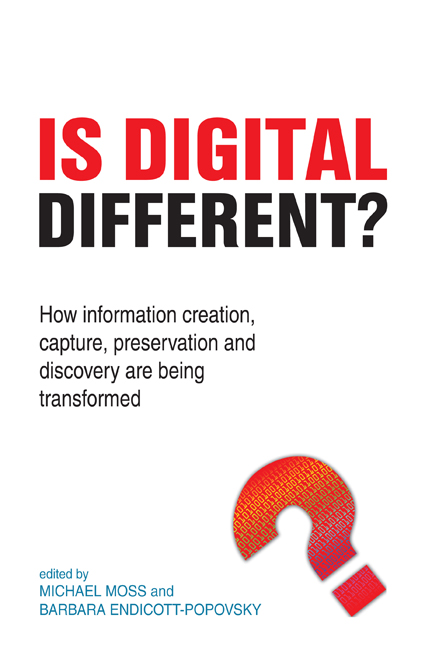 Is Digital Different?
Is Digital Different? Book contents
- Frontmatter
- Contents
- Contributors
- Introduction and acknowledgements
- 1 What is the same and what is different
- 2 Finding stuff
- 3 RDF, the Semantic Web, Jordan, Jordan and Jordan
- 4 Crowdsourcing
- 5 Pathways to integrating technical, legal and economic considerations in the design, development and deployment of trusted IM systems
- 6 Finding archived records in a digital age
- 7 Security: managing online risk
- 8 Rights and the commons: navigating the boundary between public and private knowledge spaces
- 9 From the Library of Alexandria to the Google Campus: has the digital changed the way we do research?
- Index
4 - Crowdsourcing
Published online by Cambridge University Press: 08 June 2018
- Frontmatter
- Contents
- Contributors
- Introduction and acknowledgements
- 1 What is the same and what is different
- 2 Finding stuff
- 3 RDF, the Semantic Web, Jordan, Jordan and Jordan
- 4 Crowdsourcing
- 5 Pathways to integrating technical, legal and economic considerations in the design, development and deployment of trusted IM systems
- 6 Finding archived records in a digital age
- 7 Security: managing online risk
- 8 Rights and the commons: navigating the boundary between public and private knowledge spaces
- 9 From the Library of Alexandria to the Google Campus: has the digital changed the way we do research?
- Index
Summary
What is crowdsourcing?
Introducing crowdsourcing
Crowdsourcing is increasingly emerging as a viable approach in a number of areas. It can be used to source labour for a repetitive task that needs to be done a large number of times, but is also employed to find innovative solutions to problems or to perform tasks that would be beyond one single individual to accomplish.
Crowdsourcing can take many forms but one common feature is that a task or set of tasks is performed by a number of people (‘volunteers’) who have agreed to take part. Each task can be small and quick to do, but through the input of a large number of people (‘crowd’), the combined effort and output will be considerable.
Crowdsourcing is particularly useful for tasks where the human brain and eye cannot be replaced by machines. Some crowdsourcing tasks can seem fairly uncomplicated and menial, and farming out these mind-numbing activities to a crowd may seem like a charitable approach. As will be shown below, however, many crowdsourcing projects offer stimulating and challenging tasks, providing access to material that is interesting and captivating in a context where participants can engage with the material and see the value of their contribution.
A common feature of many crowdsourcing initiatives is that volunteers are presented with some existing material and asked to perform a task or series of tasks, for example, extract information from the material, improve it or make it easier to access and share. Tasks may involve proofreading and correcting text (for example, material that has been scanned and automatically converted to text), transcribing material (for example, typing the text of a letter which is presented as an image), providing metadata (for example, identifying and keying in title and author from the title page of a digitized book) or identifying or classifying objects in different ways (for example, identifying animals in pictures, classifying galaxies by shape or adding tags to describe the content of a painting).
- Type
- Chapter
- Information
- Is Digital Different?How information creation, capture, preservation and discovery are being transformed, pp. 71 - 94Publisher: FacetPrint publication year: 2015


